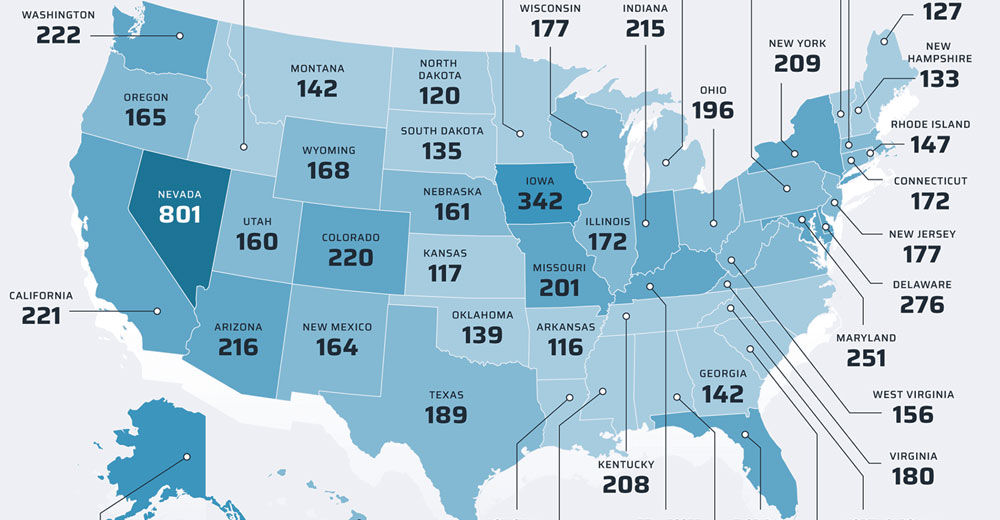A new analysis of data from the FBI’s Internet Crime Complaint Center (IC3) reveals that Nevada has more cybercrime victims than any state in the union by a large margin — 801 per 100,000 internet users, four times higher than the national average.
The analysis performed by Surfshark, a privacy protection toolset developer based in Lithuania, noted that the most common cybercrime committed in Nevada is identity theft, which could be because it’s home to Las Vegas.
“With Nevada, it’s easy to speculate that identity thieves are targeting tourists there who gamble,” Mike Parkin, a senior technical engineer at Vulcan Cyber, a provider of SaaS for enterprise cyber risk remediation in Tel Aviv, Israel, told TechNewsWorld.
In 2021, the Surfshark analysts noted, there were 9,054 victims of identity theft in Nevada or 49% of all cybercrime victims.
Other states with high cybercrime victim rates per 100,000 internet users included Iowa (342), Alaska (322), and Florida (293).
“These statistics from the FBI’s IC3 division help paint the overall picture of identity crimes reported each year in the U.S.,” explained James E. Lee, chief operating officer with the Identity Theft Resource Center (ITRC) in San Diego.
“When you add the more than 1.4 million reports of identity theft filed with the FTC in 2021, the 15,000 ID crime victims who contacted the ITRC in 2021, and the 190 million victims of data compromises tracked by the ITRC in 2021, you begin to see the enormity of the problem represented by identity crimes,” Lee told TechNewsWorld.
“The bottom line is this: There are more identity crimes reported each year in the U.S. than all other crimes combined except for larceny,” he added. “And the volume and velocity of identity crimes continue to rise along with the financial impact of them.”
Perp Hotbed
Nevada is also a hotbed for cybercriminals, with 150 perpetrators of cybercrime per 100,000 internet users, nearly three times the national average, according to the analysts.
They explained that while threat actors outside of the United States commit many cybercrimes, the FBI has identified a significant number of cybercriminals within U.S. borders. In most cases, the FBI can identify the specific state a cybercriminal is located, allowing them to see which states have the most perpetrators of cybercrime per capita.
Only two other states reached triple digits in perps per 100,000 internet users: Delaware (120) and Maryland (113).
“It’s interesting that Nevada had both the highest victim and the highest perpetrator counts, while the victims in Nevada were in the bottom three in terms of losses,” Parkin observed.
According to the analysts, the average victim of cybercrime in Nevada loses $4,728 per scam, while scammers in West Virginia average $4,280 per swindle and in Iowa $3,820.
“Without deeper analysis, it’s hard to say why the numbers play out this way,” Parkin continued, “though Nevada is unique in demographics, local culture, and major industries, all of which could play into it.”
Badlands Bad Men
“Cybercrimes are an increasing concern in Nevada and around the country,” said John T. Sandler, a spokesperson for Nevada Attorney General Aaron D. Ford.
“Our office has conducted broad campaigns meant to educate Nevadans about the many different ways scammers like to target residents in their day-to-day life,” Sandler told TechNewsWorld. “These include phishing, romance, enticement, gift card, holiday and government imposter scams.”
“AG Ford has also joined a bipartisan coalition of attorneys general who are urging the FTC to adopt a national rule targeting impersonation scams,” he added.
While losses of cybercrime victims in Nevada are among the lowest, losses in North Dakota are the highest at $31,711 per scam.
Studies have shown that the two most vulnerable age groups for cybercrime are young people under 25 years old and seniors 75 and older, the analysts noted. They reasoned that 41% of North Dakota’s population is in those age groups could be contributing to that high loss figure.
Parkin pointed out, however, that North Dakota’s small population, 774,948, could sway the statistics in the analysis.
Although the most profitable cybercrimes nationally are fund transfers through email and fake investment schemes, that’s not the case in North Dakota, where 50% of all money lost to cybercrime — $12.1 million — is lost to bandits pretending to be friends or family, or in romantic online relationships.
Other states with high per capita losses to cybercrime include New York ($19,266), South Dakota ($19,065), and California ($18,302).
Seniors Most Targeted
The analysts also revealed that the average cyber thief clears $14,048 per scam, but that, too, can fluctuate significantly from state to state, with Colorado ($33,605), Louisiana ($31,064), New York ($29,919) and Wyoming ($27,918) among the highest. Among the lowest were West Virginia ($2,630), Nebraska ($4,148), Montana ($4,327), and Connecticut ($4,394).
In the states where perpetrators steal the most, cybercriminals are likely targeting small- to mid-size businesses with financial capital, the analysts noted.
They added that the most profitable cybercrimes in New York were investment scams, which accounted for 34% of all money lost due to cybercrime in 2021. By comparison, investment scams only accounted for 19% of all money swindled through cybercrime in 2021 nationwide.
The most victimized age group of cybercrimes are seniors, the analysts noted. In 2021, 92,371 Americans 60 years old and older were bilked $1.7 billion.
While seniors lost the most to cybercrime, the analysts continued, other age groups were disproportionately victimized. For example, people in the 40 to 49-year-old group represent only 12.4% of the population but 20.8% of all cybercrime victims in the United States. On the other side of the coin, under 20-year-olds represent 24.8% of the population but only 3.5% of cybercrime victims.
There are also some variations by state, the analysts added. In 16 states, for instance, the most commonly targeted age group was 59 and under, and in Iowa, the most targeted group was 20 to 29-year-olds.
“From a ‘who can I steal from’ perspective,” Parkin said, “kids and elders are probably easier targets than people in the 40 to 49 range, but they likely have fewer resources worth targeting.”
He added that analyzing cybercrime on a state-by-state basis can be useful to crimefighters. “Understanding victim and target demographics can be used to develop specific techniques to help defend against attacks,” he said. “It can also help understand why attacks are more or less effective in different regions.”

























































